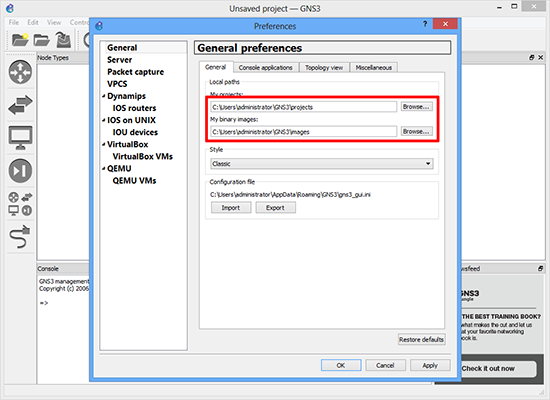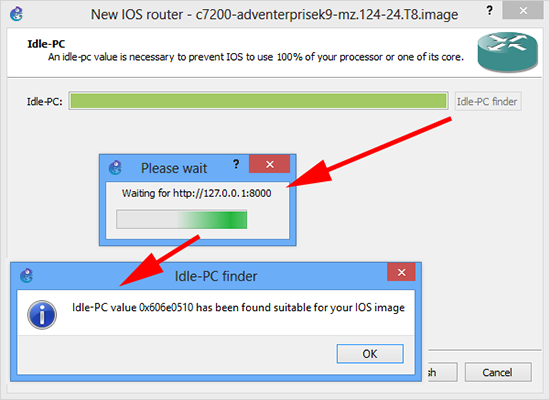KB ID 0001079
Problem
I dip into GNS3 every so often, (depending on what I’m working on). And each time I install it, I spend just as long remembering how to set it up, as I do using it! So, if for no other reason than I can use this page as a reference in future, here’s how to get it up and running.</p?
Solution
Note: At time of writing the latest version is 1.3.6</p?
1. Download GNS3, I usually accept all the defaults.
2. Edit > Preferences > Check that the path to the ‘projects’ and your ‘images’ folder are where you want them to be. The defaults are fine but if you run GNS3 on several machines you might want to choose something like Dropbox > Apply > OK.
Adding Router Images to GNS 3
3. Dynamips > IOS Routers > New > Add in your route images > Follow instructions.</p?
Note: DONT Email me and ask for router images, go to Cisco and get them legally, (or use Google).
4. Make sure you take the time to calculate the ‘Idle-PC finder’ value for each router, or in large topologies you might quickly eat all your CPU power!
5. Continue adding routers as required.</p?
6. You can now drag a router onto the workspace and power it on.
Adding a Cisco ASA to GNS3
Yes you can add Cisco PIX as well, but there’s not many of them left in the wild.
7. Edit > Preferences > Qemu > Qemu VMs > Add > Set the type to ASA 8.4(2).
8. You need two files to run the ASA, an initrd file and a kernel file. You need to create these from a legally obtained copy of the asa843-k8.bin file.</p?
Should you wish to locate these files form a less reputable source you are looking for
asa842-initrd.gz and asa842-vmlinuz, again don’t email me for them! If you are too stupid to use a search engine, then technical ninjary is not the correct career choice for you.
9. You can now drag an ASA onto the workspace and console into it (it takes a while, be patient). When the ASA starts it has all the licenses disabled, to add them you need to change the ASA’s activation key. An ASA Activation key is usually linked to the serial number of the ASA, in this case we don’t have a serial number, (that’s not strictly true, if you check, it’s something like 12345678). So I will publish a working activation key*
*Disclaimer, this will only work on this virtual ASA, and it’s published elsewhere on the Internet, if I receive a request to remove it I will do so.</p?
Another ‘quirk’ is every time you add a new ASA to the workspace, you need to go through this process, if you enter the commands below you can issue a reload and also save the ASA, without the need to re-enter the activation key.
activation-key 0xb23bcf4a 0x1c713b4f 0x7d53bcbc 0xc4f8d09c 0x0e24c6b6
{This can take 5-10 minutes}
copy running-config startup-config
{Enter}
copy startup-config disk0:
{Enter}
10. When it comes back up, (again it will take a few minutes). Your can check your ASA’s licensed features.</p?
Adding a Host to GNS3
Having a host machine for you labs is handy, usually you just need to be able to ping, or perform tracerts. So you can download a small Linux image from GNS3. There are a few options but I prefer linux-microcode.
11. Edit > Preferences > Qemu > Qemu VMs > Add > Set the type to default.
12. Give it a sensible name.
13. Navigate to, and select the disk image you downloaded above.
14. You can now drag a Qemu Guest machine onto the work space, and console into it.
Related Articles, References, Credits, or External Links
Connecting GNS3 to VMware Workstation












